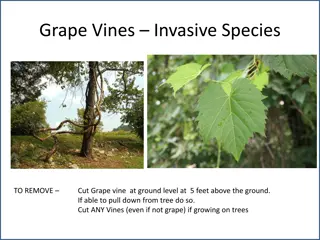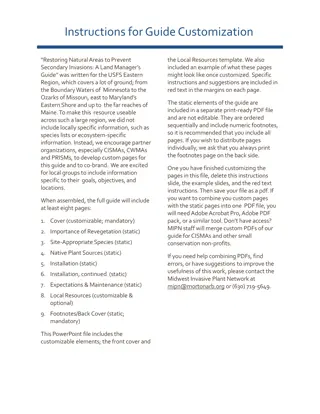Understanding the Impact of Invasive Species in Wilderness Management
Invasive species pose a significant threat to the ecosystem by causing disruptions in biodiversity and ecosystem health. This article discusses the importance of managing invasive species in wilderness areas and provides insights into creating successful Invasive Species Plans. It sheds light on the various invasive species, including insects, diseases, and plants, that have detrimental effects on the environment. Through proactive management strategies, we can minimize the introduction and spread of invasive species, preserving the natural balance of wilderness areas.
- Invasive Species
- Wilderness Management
- Ecosystem Health
- Biodiversity Conservation
- Environmental Conservation
Download Presentation

Please find below an Image/Link to download the presentation.
The content on the website is provided AS IS for your information and personal use only. It may not be sold, licensed, or shared on other websites without obtaining consent from the author. Download presentation by click this link. If you encounter any issues during the download, it is possible that the publisher has removed the file from their server.
E N D
Presentation Transcript
Wilderness Invasive Species Plans Art work by Keri Evans, 2001 Tommy Gionet SCNF
Goals Manage Wilderness Areas to Standard Satisfy NFRW WD Primary Output # 2 Number of wildernesses which successfully treated for noxious/ invasive plants. Invasive Species Management Reduce, minimize, or eliminate the potential for introduction, establishment, spread, and impact of invasive species across all landscapes and ownerships. Main Salmon River near Sheep Creek
Session Goals Provide you with a template and instruction with respect to establishing a successful Invasive Species Plan for your Wilderness Area
Why are we worried about Invasive Species in the Wilderness ? The Wilderness Act wilderness Impacts Invasive Species Executive Order 13112 (1999) USFS Strategic Plan (2004)
Invasive Species Invasive species have been characterized as a catastrophic wildfire in slow motion. "Thousands of invasive plants, insects, fish, mollusks, crustaceans, pathogens, mammals, birds, reptiles, and amphibians have infested hundreds of millions of acres of land and water across the Nation, causing massive disruptions in ecosystem function, reducing biodiversity, and degrading ecosystem health in our Nation s forests, prairies, mountains, wetlands, rivers, and oceans. Invasive organisms affect the health of not only the Nation s forests and rangelands but also of wildlife, livestock, fish, and humans.
Invasive Species Major Invasive Insects Asian longhorned beetle Hemlock woolly adelgid Emerald ash borer Gypsy moth
Invasive Species Diseases and pathogens Sudden Oak Death (SOD) canker White pine blister rust Port Orford cedar root disease
Invasive Species Plants (including aquatics and wetland) Leafy spurge Kudzu Saltcedar Mile-a-Minute
Invasive Species Plants (including aquatics and wetland) Purple loosestrife Yellow starthistle Spotted knapweed
FRANK CHURCH RIVER OF NO RETURN WILDERNESS NOXIOUS WEED MANAGEMENT PROGRAM FC-RONRW
1984: FC RONRW Management Plan Stated: Small Patches of noxious weeds and other non-native species are present in scattered locations and, although not noticeably expanding, must be considered a serious threat to natural succession. Integrated pest management strategies and techniques will be utilized to suppress or eradicate introduced undesirable plants, animals including insects, and diseases to protect the Wilderness and/ or resources outside the Wilderness commensurate with ecological, environmental and economic values.
FC-RONRW INVASIVE SPECIES PLANNING 1984 to the early 90 s Invasive Species Management was basically limited to the mechanical treatment (hand pulling and grubbing) of noxious weeds (spotted knapweed) along travel corridors and river systems. During this time Invasive Species Management (particularly noxious weed management) was becoming a national priority for land managers. 1991 USDA, FS began the FC-RONRW Management Plan Revision process. 1994 FS initiated official scoping under NEPA and held several public meetings.
FC-RONRW INVASIVE SPECIES PLANNING 1994 Rush Skeletonweed (Chondrilla juncea) was first found in the FC-RONRW in the Mackay Bar Area and along the Middle Fork of the Salmon River in 1995 By late 1998 the noxious weed management portion of the FC-RONRW Mgmt. Plan was separated from the plan as a whole and an EIS was prepared addressing just noxious weed management issues.
1999 EIS, FC-RONRW NOXIOUS WEED TREATMENTS 1999 EIS authorized integrated weed management in the wilderness, including herbicides. Herbicide treatments began in spring of 2000. Adaptive management allows for the inventory, analysis and treatment of new sites. 1999 ROD is an interim weed treatment decision until finalization of Inclusive FC-RONR Wilderness Plan.
FC-RONRW INVASIVE SPECIES PLANNING (continued) 1999 ROD & EIS only provided interim direction until the FC-RONRW Mgmt. Plan was implemented. November 2003 the FC-RONRW Mgmt Plan was signed. Work began on a Draft Supplemental EIS for FC-RONRW Noxious Weed Treatment
Frank Church River of No Return That s what the Frank Church River of No Return Wilderness managers have done, and are doing with respect to noxious weed management. NOW What can you do with respect to Invasive Species Management for your Wilderness Area.
What does my plan need to do ? Improve our understanding of and ability to MINIMIZE the impacts of invasive plant, animal (vertebrate and invertebrate ) and pathogen species to the Wilderness, in both the terrestrial and aquatic habitats.
A Plan Understand the introduction, spread and distribution of invasive species within the Wilderness. Understand the effects of these species on Wilderness values. Identify and evaluate management options and their consequences.
Balance We balance both mandates by choosing the least obtrusive action (i.e., the minimum tool) to accomplish management objectives. Maintaining natural conditions while preserving its untrammeled character. Weigh the various risks and benefits, both ecological and social, when choosing an appropriate management strategy.
National Strategy and Implementation Plan Program Elements Prevention Keep out invasive species. Early Detection and Rapid Response Detect and eradicate invasive species to stop them from spreading. Control and Management Apply integrated control techniques to manage the problem. Rehabilitation and Restoration Heal, minimize, or reverse the harmful effects from invasive species
Guiding Principles - Foundation for the National Strategy All aspects of the national strategy will include direction to implement an invasive species management program through these guiding principles: Science-based prioritization of invasive species problems, Enhanced collaboration on the solutions to those problems, and An improved system of accountability that ensures the most efficient use of limited resources at all levels of the organization.
QUESTIONS ? http://www.fs.fed.us/foresthealth/publications/Invasive_Species.pdf























